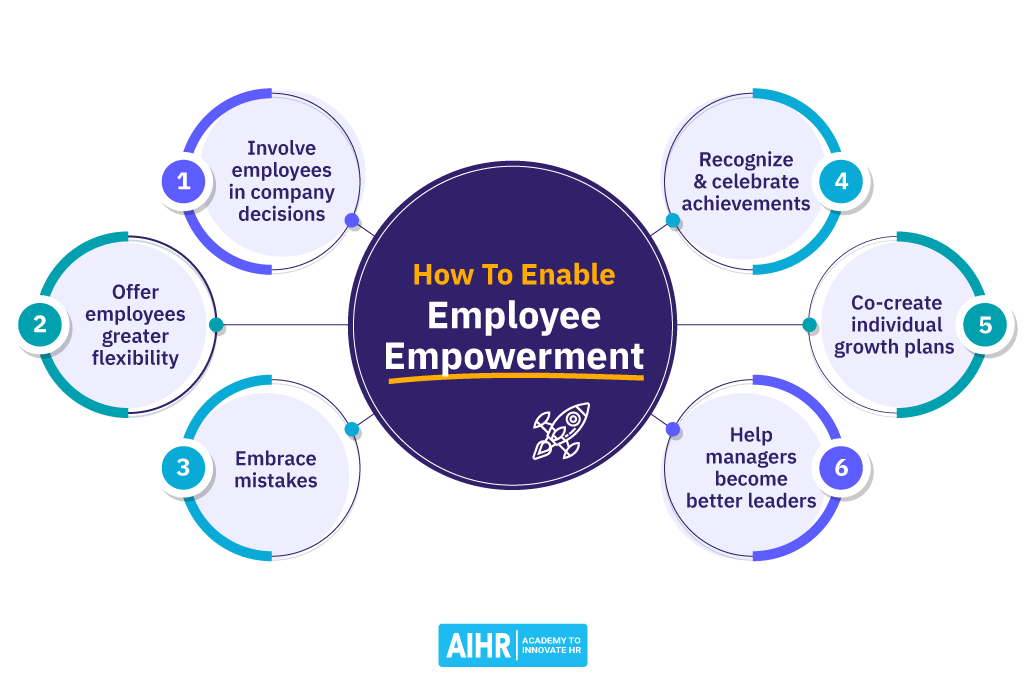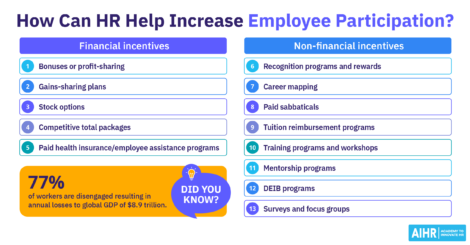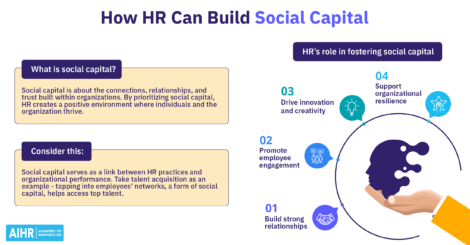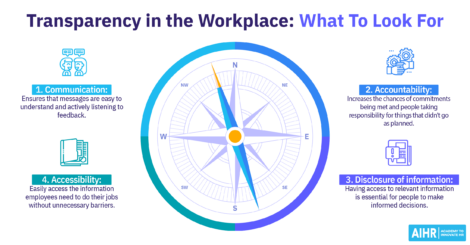7 Employee Empowerment Examples To Inspire Your Business

Employee empowerment offers many benefits for both the organization and employees, particularly when it comes to improving employee engagement and motivation.
The employee empowerment examples discussed in this article will help guide HR professionals on how to enable employees to feel empowered to share their ideas, make decisions and recognize where they can bring value to the business.
Contents
What is employee empowerment?
The benefits of employee empowerment
Employee empowerment examples for HR
What is employee empowerment?
Employee empowerment is an umbrella term for every action, initiative, process, or act that enables employees in an organization to take ownership, trust their own judgment and make decisions. The organization enables employee empowerment by providing the tools and resources as well as support and independence for employees to act autonomously.
Employee empowerment is not to be confused with employee engagement. But while these are two different things, one does lead to the other; empowered employees tend to be more engaged than those who are not.
The benefits of employee empowerment
As previously mentioned, one important benefit of employee empowerment is an increase in engagement. However, research has determined additional interesting benefits of employee empowerment.
These include:
- Increased creativity and critical thinking: Empowerment of employees enhances creativity and improves their ability to think more critically.
- Improved customer service: Empowering employees improves their decision-making skills. This, in turn, improves the quality of customer service as employees are able to resolve customer issues and embrace problem-solving as part of their professional conduct.
- Focus on personal and company growth: Managers who empower employees often encourage and respect new ideas. In turn, empowered employees are more motivated to make things better for their personal and organizational growth.
- Increased productivity, morale, and retention: As a logical consequence of these benefits, empowered employees will also have increased morale, show better results, and stay with the company longer.
Employee empowerment examples for HR
There are many ways that an organization can empower employees. Let’s take a look at some examples and scenarios illustrating how HR can aid in supporting employee empowerment.

1. Involve employees in company decisions
How often have various departments within your organization been guilty of making unilateral decisions without consulting with employees who may be impacted? Now, consider how often your HR department has made decisions on behalf of employees without including them in the process.
It isn’t uncommon in organizations to exclude employees who are likely to be most impacted by the decisions from the conversation. However, the implications of taking this approach could result in decreased morale, limited ideas, and, worst-case, a decline in productivity and an increase in turnover.
If your organization and HR department are guilty of excluding employees from decisions that will ultimately impact them the most, then it may be time to appraise and improve upon these processes as a starting point for improving employee empowerment.
Consider:
- Using a suggestion box (you can also use a digital suggestion box).
- Conducting a survey.
- Involving employees in defining their own goals and KPIs.
- Encouraging/training managers to involve their team in the decision-making process.
- Organizing brainstorming sessions/days.
Microsoft: Employee surveys
Microsoft is renowned for including its employees within processes. The company conducts employee surveys on topics such as employee development, career advancement opportunities, and even on how to handle layoffs. Results from these surveys inform changes to its employee development programs and in the creation of new career paths.
Additionally, Microsoft also posts the survey results on a public forum for all employees to access to allow for a more transparent sharing of information across the organization.
2. Equip employees to make their own decisions
Mckinsey found that decision-making takes up 70 percent of executives’ time. This leads to lost opportunities equal to more than half a million days of managers’ time. For a Fortune 500 company, this equates to $250 million a year in salaries.
To enable executives to make better use of their time, delegating decisions is critical. However, in order to delegate decisions successfully, employees need to be empowered and given the authority to act.
This requires various things, among which:
- Managers who are (trained and) confident to leave certain decisions up to the people in their team.
- Employees who know exactly what their decision-making mandate entails, including;
- When they can autonomously make decisions
- What tools are at their disposal to do so
- Where their decision-making ability ends.
Ritz-Carlton: Empowering to resolve customer issues
At Ritz-Carlton, employees at all levels are empowered to spend a dedicated amount of approximately USD 2000 per guest to resolve any customer issues without having to involve a manager. What’s important to take away from this point is not the amount the organization can spend on resolving issues but rather on equipping employees with the resources to make decisions.
In Ritz-Carlton’s words: “There is much power for all of our Ladies & Gentlemen knowing that we truly trust them with an amount that large, per incident. They are able to make decisions in the moment to quickly resolve a guest issue or to make an experience beautiful and memorable (or both). And our Ladies & Gentlemen know they can do this on their own, regardless of their level, without having to go through levels of leadership for approval.”
3. Offer employees flexibility
Pre-pandemic, physical proximity to colleagues was considered critical for innovation, collaboration and getting work done. However, the introduction of flexible working has turned these assumptions on its head. When managed effectively and with the right tools and resources to empower employees, flexible working leads to increased productivity and innovation.
According to BP, in the Future of Work report, “When operating well, flexible working creates more of a performance culture, as it drives measurement of output rather than presence.”
However, flexible working must be grounded on autonomy and support in order to succeed. Here are a few tips to make this happen:
- Ensure that employees have access to collaborative tools.
- Create guiding principles to enable collaboration.
- Rethink the role of the office, for instance, creating spaces where people come together to gather, brainstorm or meet clients.
Reworked: Enabling trust and collaboration
Reworked introduced a working model they called the ‘empowered hybrid model’. The native digital publication made it voluntary to come into the office across most positions. The company’s philosophy is ‘Get your work done wherever works best.’
The company has created guiding principles to enable collaboration within its new hybrid work model. These include redesigning their headquarters to include an ‘onsite offsite’ space.
“Gone are the days when people must work in the office just because. But we have found that when there is a specific reason to come in, and it happens organically, and we make it productive and fun, the effect is powerful,” explains chief executive officer, Andy MacMillan.
“For instance, one of our teams recently held an onsite off-site, but others with a matrixed relationship to that team wanted to come in and spend time with them. It led to the sort of collaboration and trust-building that sometimes happens best in person.”
Additionally, Reworked encourages employees to avoid mixed-mode meetings and to rather have either a fully virtual meeting or fully on-site, whichever makes the most sense. This enables better, less disjointed conversations between colleagues.
4. Embrace mistakes
Managers in high-performing cultures promote mistake-making and support making experiments. Employees are encouraged to take risks and learn from their mistakes.
However, enabling employees to make mistakes and learn from them requires a top-down change in approach.
When asked to agree or disagree with the statement “My company creates an environment where people can try, fail and learn from mistakes.” in a global Gallup study, only 20% of German employees, 21% of US employees, and 22% in France strongly agreed. This illustrates that companies are failing to create a culture where mistakes are made.
In order to help create a culture of learning, HR can:
- Encourage managers to admit their own mistakes and discuss learnings with their team.
- Create a formal platform where learnings can be shared.
- Celebrate mistakes that have been turned into successes or critical learnings.
- Encourage managers to treat their employees as a partner working towards a shared goal.
Netflix: Do what is best for the company
Netflix has a culture of encouraging its employees to make mistakes and speak about them openly.
As Netflix CEO, Reed Hastings, describes, “When you succeed, speak about it softly or let others mention it for you. But when you make a mistake say it clearly and loudly, so that everyone can learn and profit from your errors. In other words, ‘Whisper wins and shout mistakes’.”
5. Recognize and celebrate achievements
A survey conducted by OnePoll revealed that 46% of U.S. workers resigned from a job because they felt unappreciated. Additionally, 65% of respondents indicated that they would work harder if their contributions were noticed by management.
In order to ingrain employee recognition into the organization’s culture, People Teams can:
- Involve managers and have them role model what recognition looks like.
- Show the importance of employee recognition in the organization’s employer branding and hiring process.
- Develop and implement an employee (and/or peer) recognition program.
- Communicate frequently and clearly about the company’s employee recognition program to ensure that everyone in the organization knows about it.
E.On: Thank you notes
German utility company E.On encouraged its employees to recognize co-workers via digital and physical thank-you notes. As the company had no organizational hierarchies, people could receive a thank you from anyone in the organization.
Senior executives ended up saying thank you by leaving (physical) post-it notes to almost a thousand employees. As a result, employee motivation increased from 61% to 69%, with employees that felt valued increasing from 39% to 52%.
6. Co-create individual growth plans
Growth and development opportunities matter to employees and candidates. According to an Indeed survey, 19% of job seekers started looking for a new job because they wanted a promotion or more career growth opportunities.
Employee empowerment, however, goes beyond offering career growth opportunities. HR can further empower employees by providing them with the opportunity to take ownership of their own growth and career development.
Here are a few ways for HR to do this:
- Offer people development opportunities such as job rotation or job shadowing.
- Involve employees in setting their own goals and KPIs.
- Offer mentorship programs and/or micro-mentoring.
- Allocate time during people’s work week to focus on, for instance, learning a new skill.
GoDaddy: Encouraging employee growth
Based on the results of a 2019 employee survey, GoDaddy introduced an internal program called MyCareer. The program features an intranet portal where employees can find all things career-related. This includes leveling guides from across the company for employees to better understand what’s expected of them in their role, training, workshops, conversation guides, and more.
As a result of this investment in employee growth, GoDaddy has seen its employee engagement improve. The MyCareer program has also successfully prepared employees to take the next step in their career within the company.
7. Help managers become better leaders
Managers play an essential role in empowering employees. Great managers know how to encourage their employees to take on a project or activity that might be out of their comfort zone but could help them expand their skills and accomplish more than they thought possible.
People Teams can help managers become better leaders by:
- Offering them adequate training. Not every manager will need the same type of training so, first, understand where the skills gaps lie.
- Onboarding new managers, especially if people are taking on their first management role.
- Offer them coaching and/or mentoring where required.
CultureAmp: A genuine desire to see people succeed
A great manager is invested in the lifelong success of the people in their team. They support their employees’ entire trajectory.
Here’s how Didier Elzinga, the CEO of Culture Amp describes it: “Authenticity and a genuine desire to see people succeed breeds loyalty. I want Culture Amp to be the dream job for our people, but if it’s not, I want it to be their stepping stone to a dream job.”
Key takeaways
- Involve employees in company decisions: Include employees in the decision-making process on matters that directly impact them or their work.
- Equip employees to make their own decisions: Give employees the trust and the tools they need to make decisions on their own.
- Offer employees flexibility: Where possible, offer flexible working, but have clear guidelines to enable collaboration.
- Embrace mistakes: Create a culture that sees mistakes as learning opportunities.
- Recognize and celebrate achievements: Engrain employee recognition into your company culture.
- Co-create individual growth paths: Involve employees in setting their own goals and KPIs.
- Help managers become better leaders: Equip managers with the tools they need to empower their teams.
Weekly update
Stay up-to-date with the latest news, trends, and resources in HR
Learn more
Related articles
Are you ready for the future of HR?
Learn modern and relevant HR skills, online












